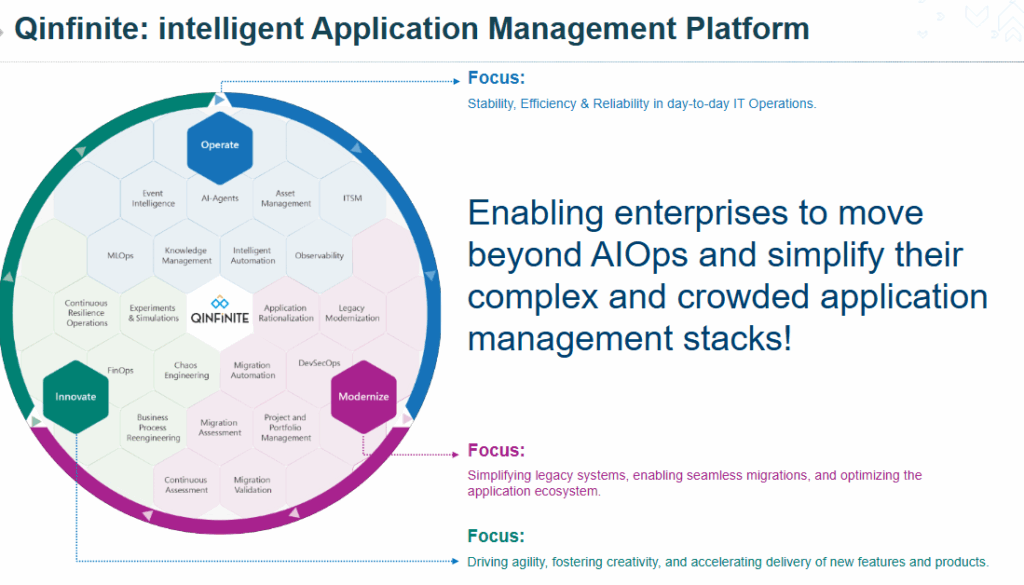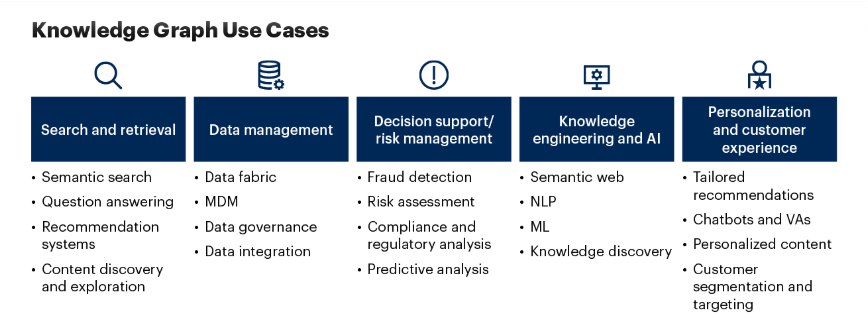In today’s digital enterprises, system complexity has skyrocketed. Distributed architectures, hybrid cloud environments, and microservices have made incident management and root cause analysis (RCA) more challenging than ever. Moreover, with sprawling infrastructures, traditional tools are simply no longer enough to manage the velocity, scale, and intricacies of modern IT operations.

This is where Qinfinite steps in. Our advanced intelligent Application Management (iAM) platform, powered by AI, revolutionizes the way enterprises handle incidents. But Qinfinite is not just about detecting problems — it’s about intelligently resolving them in real time, reducing the time to recovery, and ultimately driving operational excellence.
From Logs to Insights: The Cognitive Core of Qinfinite
At the heart of Qinfinite lies a semantic log intelligence engine, powered by domain-trained Large Language Models (LLMs). This sophisticated engine works tirelessly to:
- Parse and interpret log data, metrics, and events in real time: This allows Qinfinite to make sense of massive amounts of data at scale, providing instant insights and eliminating the lag associated with manual or rule-based analysis.
- Detect latent correlations and anomalies: Using vector embedding and temporal clustering, Qinfinite is able to detect hidden relationships between seemingly unrelated events and surface critical issues before they escalate.
- Generate natural language RCA summaries for faster human validation: The platform doesn’t just provide data; it transforms complex technical information into easily digestible, human-readable narratives. This speeds up decision-making and enhances collaboration among teams.
Knowledge Graphs: Mapping the Enterprise Nervous System

Qinfinite builds and continuously updates a dynamic, enterprise-specific Knowledge Graph (KG), which acts as the “situational memory” of the platform. The KG:
- Models all system components and their relationships: This includes apps, services, APIs, infrastructure layers, and their intricate dependencies, data flows, and service call chains.
- Enables semantic traversal and inference across multi-modal data: Logs, metrics, traces, and even tickets are all integrated and analyzed in context, providing a holistic view of your entire system.
- Supports context-aware agent reasoning: By grounding AI outputs in both topological and relational context, Qinfinite ensures that every decision made by the system is based on deep knowledge of your unique enterprise environment.
This knowledge graph serves as a critical tool for the platform’s AI agents, empowering them to reason not just based on what they observe, but on a rich understanding of the entire system’s architecture.
Qinfinite Service Catalog: Powering Smart Actions and GenAI Workflows
Qinfinite’s Service Catalog is much more than a list of automation scripts — it’s the brain behind how actions are executed across your IT systems. Think of it as a “smart action library” that allows GenAI agents for IT operations to:
- Execute ready-to-use actions: The catalog houses pre-approved scripts, APIs, and workflows that can fix common issues like restarting a failed service, clearing cache, or scaling up a server.
- Enable agentic AI workflows: The catalog powers multi-step processes, allowing GenAI agents to autonomously make decisions and resolve issues, all while adhering to enterprise-specific policies and rules.
- Ensure safe and controlled execution: Every action comes with built-in compliance rules — including who can run them, when, and under what conditions — ensuring security and governance.
Creating GenAI Agentic Workflows with Service Catalog
What makes the Qinfinite Service Catalog really powerful is how it enables agentic workflows — multi-step processes where GenAI agents think, decide, and act on their own to fix problems.
Here’s an example:
In case of a service running slow, Qinfinite detects the slowdown, investigates logs, identifies the root cause (say, memory leak), selects a memory cleanup script from the Service Catalog, requests approval, and runs the script — all without human intervention.
These GenAI workflows can even chain multiple actions: Diagnose the issue →Validate a hypothesis →Run a test action →Monitor results →Apply the final fix
All of this is coordinated through the Service Catalog.
“If the GenAI agent is the brain making decisions, the Service Catalog is the arm and fuel that powers those decisions into action.”
Hypothesis & Causality: Going Beyond Surface-Level Anomalies
Qinfinite doesn’t just surface anomalies; it dives deep to form and test hypotheses using causal graphs and Bayesian inference. This allows the platform to:
- Determine causality of metric anomalies and log errors: Instead of simply flagging issues, Qinfinite identifies why an anomaly is happening and how it fits into the bigger picture.
- Understand event causation and time-space relationships: Using causal models and GenAI algorithms, Qinfinite can understand what happened first, even across distributed logs and systems — providing a true timeline of events.
This level of understanding is key to accelerating resolution and ensuring that the right action is taken at the right time.
From Chaos to Clarity: Root Cause Analysis Reimagined
Traditional log analysis and incident response models are slow, reactive, and prone to human error. They rely heavily on rule-based engines or manual investigation. Qinfinite transforms this with AI-driven RCA agents that:
- Ingest and understand logs at scale: By using LLMs fine-tuned on historical incidents, configurations, and topology data, Qinfinite can interpret vast amounts of data and correlate it with past learnings.
- Correlate anomalies across logs, metrics, and traces: Real-time identification of the root cause becomes possible when anomalies are linked across the entire ecosystem.
- Generate detailed RCA narratives: Qinfinite provides clear, concise explanations in human-readable formats. For instance, a root cause could be summarized as: “High CPU utilization on Node-X led to thread pool exhaustion in Service-Y, causing timeout exceptions in API-Z.”
It’s like having a digital Site Reliability Engineer (SRE) that never sleeps.
| Action | Impact on MTTR | Impact on MTBF | Impact on Availability |
|---|---|---|---|
| Reduce MTTR | Decreases | Increases slightly | Increases significantly |
| Increase MTBF | Increases | Increases significantly | Increases moderately |
| Action | Impact on MTTR | Impact on MTBF | Impact on Availability |
|---|---|---|---|
| Reduce MTTR | Decreases | Increases slightly | Increases significantly |
| Increase MTBF | Increases | Increases significantly | Increases moderately |
From Resolution to Execution: Autonomous Remediation
Where Qinfinite truly shines in its Intelligent Automation. Once the root cause is identified, our actionable AI agents don’t just recommend solutions — they execute them:
- AI-driven remediation: The platform uses previous successful outcomes, validated through a Reinforcement Learning with Human Feedback (RLHF) loop, to recommend and execute fixes.
- Automated workflows: Actions are triggered automatically via the Service Catalog, significantly reducing MTTR (Mean Time to Resolution) and human dependency.
- Level 0/1 ticket automation: Qinfinite’s automation can handle routine tasks (like clearing logs or restarting services) without human involvement, freeing up your team to focus on more strategic initiatives.
Business Value: More Than Just Tech Efficiency
For CXOs and IT leaders, Qinfinite isn’t just another application monitoring tool — it’s a business enabler. Here’s the tangible value it brings to your organization:
- Lower Operational Costs: Automating L1/L2 activities reduces manual labor, saving thousands of hours annually.
- Improved Uptime: Proactive remediation and fast issue resolution ensure SLA adherence and enhance customer satisfaction.
- Data-Driven Decision Making: Every incident, every resolution, is documented, analyzed, and fed back into the learning loop, helping you make informed decisions.
Under the Hood: Why Qinfinite is Different
Here’s why Qinfinite stands out in a crowded market of AIOps tools:
- LLMOps Engine: Qinfinite fine-tunes domain-specific LLMs with enterprise logs, leveraging advanced prompt engineering and embedding models to ensure deep understanding and accurate insights.
- Context-Aware Agent Framework: Every GenAI agent is context-aware, meaning it understands everything from system topology to temporal patterns — ensuring it makes the best decisions every time.
- Responsible AI: With built-in controls for explainability, confidence scoring, and compliance, Qinfinite ensures that AI actions are not only intelligent but also transparent and regulatory-compliant (critical in regulated industries).
Final Note
In summary, Qinfinite is not just a tool for managing IT incidents. It’s a holistic solution that helps enterprises pre-empt, understand, and resolve issues intelligently, empowering businesses to achieve operational excellence at scale. With GenAI agents that think, act, and learn, Qinfinite delivers faster RCA, self-healing capabilities, and an overall transformational shift in how IT operations run.
Ready to experience the future of intelligent application management? Let Qinfinite help you transform your enterprise operations today.
FAQs About Qinfinite’s GenAI-Powered Application Management
Intelligent Application Management (iAM) refers to an advanced approach to managing and optimizing applications by using intelligent automation and real-time analytics. It combines performance monitoring, troubleshooting, and predictive insights to ensure that applications run smoothly. The goal of iAM is to improve the user experience and operational efficiency while proactively identifying and solving issues before they impact the business.
Qinfinite stands out from traditional monitoring tools by moving beyond basic performance tracking. Unlike conventional tools that simply alert you when something goes wrong, Qinfinite takes a more proactive approach. It not only detects issues but also performs root cause analysis (RCA) and uses AI-driven insights to predict potential problems before they occur. This enables businesses to resolve issues faster, minimize downtime, and maintain optimal performance with a more strategic and intelligent approach.
Qinfinite uses advanced machine learning algorithms to dig deep into system data and identify patterns that lead to issues. Instead of just pointing out the surface-level symptoms, Qinfinite traces the problem back to its root cause. By analyzing vast amounts of data in real-time, it can isolate the exact source of the problem, whether it’s related to infrastructure, code, or external dependencies. This helps teams quickly address the core issue, rather than just treating the symptoms.
Yes, Qinfinite fully supports hybrid cloud and microservices environments. As modern IT infrastructures become more complex, Qinfinite is designed to manage and monitor systems that span across both on-premises and cloud-based environments. It provides visibility into microservices architectures, helping businesses understand how different components interact and ensuring smooth operations, regardless of where the services are hosted.
